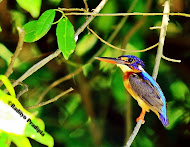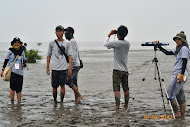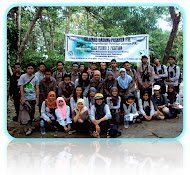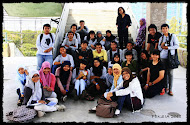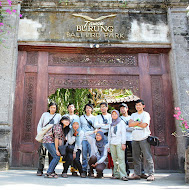Banded Pitta (Pitta guajana). In Indonesia, it called Paok Pancawarna.









By IUCNredlist



























By IUCNredlist








 By IUCNredlist
By IUCNredlist













































By IUCNredlist
| Scientific classification | |
|---|---|
| Kingdom: | Animalia |
| Phylum: | Chordata |
| Class: | Aves |
| Order: | Passeriformes |
| Family: | Pittidae |
| Genus: | Pitta |
| Species: | P. guajana |
| Binomial name | |
| Pitta guajana (Müller, 1776) | |
Description: Easily recognizable, medium-sized (22 cm), fat-bodied, golden colored stripes. Head black with conspicuous yellow eyebrows and the typical width. Brown back and wings with white wing line, blue tail, white chin. Races on each island has the characteristics of each. Ras Borneo and Java: chest and stomach side striped black and yellow races of Sumatra: a striped blue and orange. Males in Java: there is a blue line on the upper chest, race Kalimantan: blue patches on the chest. Ras Sumatra: blue belly and neck orange, white wings over the line width. Female: darker and redder.
Iris brown, beak and black legs.
Sound: a) Somewhat loud "pa-oh" high voice "pieuw" or b) a soft voice "parrrr".
Global deployment: Peninsular Malaysia and the Great Sunda.
Local spread and status: In Sumatra, is mostly found in the lowlands to a height of 500 m. In Kalimantan, recorded in the lowlands, but mostly in the hills at an altitude between 500-1500 m. The spread of the islands are somewhat limited. In Java and Bali, are not commonly found in the forest to a height of 1,500 m, but is very much visible in certain places. The remaining population in the forests still withstand the pressures of large-scale arrests, at least in the short term.
Habits: Likes primary forest and secondary forest is closed, quickly jumping along the floor or along the shaft to death. Sometimes found in low bushes, on tree bark or rattan. Are shy, sometimes seen jumping through the trail in the woods, but more often just heard his voice. In the evening perched on low vegetation, just as high as 1-3 m from the ground.
Iris brown, beak and black legs.
Sound: a) Somewhat loud "pa-oh" high voice "pieuw" or b) a soft voice "parrrr".
Global deployment: Peninsular Malaysia and the Great Sunda.
Local spread and status: In Sumatra, is mostly found in the lowlands to a height of 500 m. In Kalimantan, recorded in the lowlands, but mostly in the hills at an altitude between 500-1500 m. The spread of the islands are somewhat limited. In Java and Bali, are not commonly found in the forest to a height of 1,500 m, but is very much visible in certain places. The remaining population in the forests still withstand the pressures of large-scale arrests, at least in the short term.
Habits: Likes primary forest and secondary forest is closed, quickly jumping along the floor or along the shaft to death. Sometimes found in low bushes, on tree bark or rattan. Are shy, sometimes seen jumping through the trail in the woods, but more often just heard his voice. In the evening perched on low vegetation, just as high as 1-3 m from the ground.
Next, this bird is Rufous-backed Kingfisher (Ceyx rufidorsa) or some people called Oriental Dwarf Kingfisher/Black-backed Kingfisher (Ceyx erithaca) because some people look at its synonym. In Indonesia, it called Udang Punggung Merah or some people called Udang Api. But, in IUCNredlist, both is a difference spesies. IUCNredlist is categorized this bird into Ceyx rufidorsa because its backed is rufous colour.
Description: Measuring very small (14 cm), reddish. Yellow lower body, upper body of an old rust red, with purple reflections and purple stripe on the back to or below the upper tail cover. The difference with the shrimp's back is a black-red-rust color than black coat, no blue spots on the forehead and behind the eyes.
Iris brown, beak and red legs.
Sounds: a squeaky high-pitched whistling removed during the flight.
Global deployment: Peninsular Malaysia, Sumatra, the islands off the coast of western Sumatra, Borneo, Java, and Bali.
Local spread and status: Uncommon in primary forest and secondary lowland forests and mangrove forests.
Habits: Shy. Living in the dense forest floor below, near small streams. Flying so fast as sound.
Note: The transition between these species and the Black-backed Kingfisher are common, therefore, some experts follow Simms (1959), put both types into one type of many forms of the Oriental Dwarf Kingfisher Ceyx erithaca
Iris brown, beak and red legs.
Sounds: a squeaky high-pitched whistling removed during the flight.
Global deployment: Peninsular Malaysia, Sumatra, the islands off the coast of western Sumatra, Borneo, Java, and Bali.
Local spread and status: Uncommon in primary forest and secondary lowland forests and mangrove forests.
Habits: Shy. Living in the dense forest floor below, near small streams. Flying so fast as sound.
Note: The transition between these species and the Black-backed Kingfisher are common, therefore, some experts follow Simms (1959), put both types into one type of many forms of the Oriental Dwarf Kingfisher Ceyx erithaca
Next, this bird is Lesser Adjutant (Leptoptilos javanicus). In Indonesia, it called Bangau Tongtong. Now, it is vulnerable.
By IUCNredlist
| Scientific classification | |
|---|---|
| Kingdom: | Animalia |
| Phylum: | Chordata |
| Class: | Aves |
| Order: | Ciconiiformes |
| Family: | Ciconiidae |
| Genus: | Leptoptilos |
| Species: | L. javanicus |
| Binomial name | |
| Leptoptilos javanicus Horsfield, 1821 | |
Description: Very large (110 cm), black and white with a large beak. Wings, back and tail black; lower body and white collar. Bald head, neck and throat with pink feathers on the crown soft white cotton. Stork is a large difference with the smaller size, wing uniform, and no throat sac.
Sound: Silent, but hiss at the nest, flapping wings, and pat half.
Global deployment: India, southern China, southeast Asia, and the Great Sunda.
Local spread and status: Vulnerable (Collar et al. 1994). Not uncommon in eastern Sumatra. In southern Sumatra, reported the existence of this group between 40-50 individuals. In Borneo, there are rather rare and local, but the nest was recorded in south-central Kalimantan. In Java and Bali was once common but now rarely found in open areas.
Habits: Visit the fields, open pastures are burned or flooded, burnt mud and mangroves. Often seen floating in the rising hot air, or in small groups with other herons or even by eagles. Nested in groups in a wooded area.
Sound: Silent, but hiss at the nest, flapping wings, and pat half.
Global deployment: India, southern China, southeast Asia, and the Great Sunda.
Local spread and status: Vulnerable (Collar et al. 1994). Not uncommon in eastern Sumatra. In southern Sumatra, reported the existence of this group between 40-50 individuals. In Borneo, there are rather rare and local, but the nest was recorded in south-central Kalimantan. In Java and Bali was once common but now rarely found in open areas.
Habits: Visit the fields, open pastures are burned or flooded, burnt mud and mangroves. Often seen floating in the rising hot air, or in small groups with other herons or even by eagles. Nested in groups in a wooded area.
Next, this bird is White-bellied Sea-eagle or White-bellied Fish-eagle (Haliaeetus leucogaster). In Indonesia, it called Elang Laut Perut Putih or ELPP.
That photos above is when it was adult/mature. But, this photo below is when it was juvenile
By IUCNredlist
| Scientific classification | |
|---|---|
| Kingdom: | Animalia |
| Phylum: | Chordata |
| Class: | Aves |
| Order: | Falconiformes (or Accipitriformes, q.v.) |
| Family: | Accipitridae |
| Genus: | Haliaeetus |
| Species: | H. leucogaster |
| Binomial name | |
| Haliaeetus leucogaster Gmelin, 1788 | |
Description: large-sized (70 cm). White, gray, and black. Adults: head, neck, and the bottom white wings, back and tail gray, black primary feathers. Adolescents: the white color on the adult replaced with pale brown and gray color replaced the dark brown color. Tail wedge shape that resembles a trademark.
Iris brown, beak and sera of gray, hairless legs and feet: gray brown.
Sound: loud screams like hornbill "ah-ah-ah-...".
Global deployment: India, southeast Asia, the Philippines, Indonesia to Australia.
Local spread and status: settlers are common around coastal areas, large lakes, and rivers near the coast, across the Great Sunda region.
Habits: a beautiful eagle is often seen perched on a tree with a very upright on the edge of the waters, the reef area, or on top of the charts. Hover and glide with the beautiful and graceful, with wings uplifted to form the letter V. Wings to fly with a slow, but powerful. Catch fish in the sea with a stunning dive, the body barely wet when the fish caught in its claws. Build a solid nest in tall trees, made of branches and twigs. Nests are used for many years.
Iris brown, beak and sera of gray, hairless legs and feet: gray brown.
Sound: loud screams like hornbill "ah-ah-ah-...".
Global deployment: India, southeast Asia, the Philippines, Indonesia to Australia.
Local spread and status: settlers are common around coastal areas, large lakes, and rivers near the coast, across the Great Sunda region.
Habits: a beautiful eagle is often seen perched on a tree with a very upright on the edge of the waters, the reef area, or on top of the charts. Hover and glide with the beautiful and graceful, with wings uplifted to form the letter V. Wings to fly with a slow, but powerful. Catch fish in the sea with a stunning dive, the body barely wet when the fish caught in its claws. Build a solid nest in tall trees, made of branches and twigs. Nests are used for many years.
Next, this bird is Crested Serpent-eagle (Spilornis cheela). In Indonesia, it called Elang-ular Bido.
| Scientific classification | |
|---|---|
| Kingdom: | Animalia |
| Phylum: | Chordata |
| Class: | Aves |
| Order: | Accipitriformes |
| Family: | Accipitridae |
| Genus: | Spilornis |
| Species: | S. cheela |
| Binomial name | |
| Spilornis cheela Latham, 1790 | |
Description: Sized being (50 cm), dark colored. Very broad rounded wings, short tail. Adults: upper body dark brown gray, brown the lower body. Abdomen, sides, and white speckled stomach, there is a wide gray line in the middle of the black stripes on the tail. Crest short and wide, black and white. His trademark is the yellow skin without hair between the eyes and beak. At the time fly, wide white stripes seen on the tail and the white line on the edge of the rear wing. Ras Kalimantan and paler brown color. Teens: like adults, but more brown and more white on the feathers.
Iris yellow, beak brown-gray, and yellow legs and its sera too
Sound: Very noisy, hovering above the forest, loud and shrill sound "cue-liu", "kwiiik-kwi", or "all-liik liik" typical, with an emphasis on the last two notes, and "kokokoko "soft.
Global deployment: India, southern China, southeast Asia, Palawan, and the Great Sunda.
Local spread and status: There are in all the Great Sunda and probably the most common hawk in the wooded area to a height of 1900 m.
Habits: Often seen flying above the circular forests and plantations, between partners often call each other. At the time of courtship, the couple showed amazing aerobatics movements, although usually not very nimble. Often perched on a large branch in a shaded forest while observing the surface of the ground beneath him.
Iris yellow, beak brown-gray, and yellow legs and its sera too
Sound: Very noisy, hovering above the forest, loud and shrill sound "cue-liu", "kwiiik-kwi", or "all-liik liik" typical, with an emphasis on the last two notes, and "kokokoko "soft.
Global deployment: India, southern China, southeast Asia, Palawan, and the Great Sunda.
Local spread and status: There are in all the Great Sunda and probably the most common hawk in the wooded area to a height of 1900 m.
Habits: Often seen flying above the circular forests and plantations, between partners often call each other. At the time of courtship, the couple showed amazing aerobatics movements, although usually not very nimble. Often perched on a large branch in a shaded forest while observing the surface of the ground beneath him.
Next, this bird is Green Peafowl (Pavo mutivus). In Indonesia, it called Merak Hijau. Now, it is endangered.
by IUCNredlist
| Scientific classification | |
|---|---|
| Kingdom: | Animalia |
| Phylum: | Chordata |
| Class: | Aves |
| Order: | Galliformes |
| Family: | Phasianidae |
| Subfamily: | Phasianinae |
| Genus: | Pavo |
| Binomial name | |
| Pavo muticus Linnaeus, 1766 | |
| Subspecies | |
Description: Typical, very large (210 cm male, female 120 cm), with a cover of a very long tail (males only), and upright crest on its head. Males: coat, neck, and chest glossy green, "tail" fan made of feathers, shiny with eye-shaped spots. Less good coat color, whitish on the bottom. Not have a "tail" in length.
Iris and beak brown, dark gray legs.
Voice: "Kay-yaw" loud as a trumpet, at dusk and dawn.
Global deployment: Assam, parts of southwestern China, Indochina, and Java.
Local spread and status: Vulnerable (Collar et al. 1994). Java is now generally confined to the forest edge Ujung Kulon National Park (West Java) and savanna forest in Baluran National Park (East Java). Elsewhere are extinct or highly dispersed.
Habits: Visit the open forest to pasture, plantations of tea or coffee, take a walk on the ground. Males exhibit a developed tail cover or alternately repel other males in the breeding season. Sleep on a bare tree high in the evening.
Iris and beak brown, dark gray legs.
Voice: "Kay-yaw" loud as a trumpet, at dusk and dawn.
Global deployment: Assam, parts of southwestern China, Indochina, and Java.
Local spread and status: Vulnerable (Collar et al. 1994). Java is now generally confined to the forest edge Ujung Kulon National Park (West Java) and savanna forest in Baluran National Park (East Java). Elsewhere are extinct or highly dispersed.
Habits: Visit the open forest to pasture, plantations of tea or coffee, take a walk on the ground. Males exhibit a developed tail cover or alternately repel other males in the breeding season. Sleep on a bare tree high in the evening.
Next, this bird is Black-tighted Falconet (Microhierax fringillarius). In Indonesia, it called Alap-alap Capung.
By IUCNredlist
| Scientific classification | |
|---|---|
| Kingdom: | Animalia |
| Phylum: | Chordata |
| Class: | Aves |
| Order: | Falconiformes |
| Family: | Falconidae |
| Genus: | Microhierax |
| Species: | M. fringillarius |
| Binomial name | |
| Microhierax fringillarius (Drapiez, 1824) | |
Description: Small sized (15 cm), black and white. Upper body is black, with white spots on the inside and secondary feathers on the tail. White chest, abdomen rust red, black thigh. Part of the front and black earmuffs, surrounded by white lines or spots. Teens face the color washed pink.
Iris dark brown, gray beak, gray legs.
Sound: Loud, high screams "syiiw" fast and repeatedly "-kli -kli -kli-kli".
Global deployment: Peninsular Malaysia and the Great Sunda.
Local spread and status: In Sumatra and Kalimantan (except in the north) are generally found in lowland forest up to an altitude of 1,000 m. Now rarely found in Java and Bali.
Habits: Sit perched in an open area on the edge of a forest or an open village, including in the area of rice fields. Catch dragonflies and other insects are fierce and sudden, sometimes daring to attack small birds and other prey. Nesting in tree holes.
Note: Some experts consider kestrel is similar to M. caerulescens.
Iris dark brown, gray beak, gray legs.
Sound: Loud, high screams "syiiw" fast and repeatedly "-kli -kli -kli-kli".
Global deployment: Peninsular Malaysia and the Great Sunda.
Local spread and status: In Sumatra and Kalimantan (except in the north) are generally found in lowland forest up to an altitude of 1,000 m. Now rarely found in Java and Bali.
Habits: Sit perched in an open area on the edge of a forest or an open village, including in the area of rice fields. Catch dragonflies and other insects are fierce and sudden, sometimes daring to attack small birds and other prey. Nesting in tree holes.
Note: Some experts consider kestrel is similar to M. caerulescens.
Next, this bird is Blue-eared Barbet (Megalaima australis). In Indonesia, it called Takur Tenggeret.
NB : We are so sorry for two photos above. It must be Megalaima australis, not Megalaima armilliaris.
By IUCNredlist
| Scientific classification | |
|---|---|
| Kingdom: | Animalia |
| Phylum: | Chordata |
| Class: | Aves |
| Order: | Piciformes |
| Family: | Megalaimidae |
| Genus: | Megalaima |
| Species: | M. australis |
| Binomial name | |
| Megalaima australis (Horsfield, 1821) | |
Description: Small sized (18 cm). Crown and chin blue; malar stripe and black lines on the throat. Ras Java australis: the yellow cheeks and chest, the shape of Borneo and Sumatra duvauceli: red cheeks and sides of the head (no yellow).
Iris brown, beak black, feet greenish gray.
Sound: Sound crackling quickly: "tatrrak", over and over again as if no stop, sent about one hundred times per minute while constantly turning his head. Also vibration buzzing, repeated more slowly (like a pea whistles), the head does not move.
Global deployment: India east to southwest China, Borneo, Sumatra, Java, and Bali.
Local spread and status: General contained in the primary forest, plantations and secondary forests, from sea level to an altitude of 2,000 m.
Habits: Often heard in the woods, though hard to see. Living alone or in pairs, joined quietly pigeon and other birds to feed on the fig tree. Nesting in small holes in trees, often under the branches.
Iris brown, beak black, feet greenish gray.
Sound: Sound crackling quickly: "tatrrak", over and over again as if no stop, sent about one hundred times per minute while constantly turning his head. Also vibration buzzing, repeated more slowly (like a pea whistles), the head does not move.
Global deployment: India east to southwest China, Borneo, Sumatra, Java, and Bali.
Local spread and status: General contained in the primary forest, plantations and secondary forests, from sea level to an altitude of 2,000 m.
Habits: Often heard in the woods, though hard to see. Living alone or in pairs, joined quietly pigeon and other birds to feed on the fig tree. Nesting in small holes in trees, often under the branches.
Next, this bird is Oriental Dollarbird or Asian Dollarbird (Eurystomus orientalis). In Indonesia, it called Tiong Lampu Biasa.
By IUCNredlist
| Scientific classification | |
|---|---|
| Kingdom: | Animalia |
| Phylum: | Chordata |
| Class: | Aves |
| Order: | Coraciiformes |
| Family: | Coraciidae |
| Genus: | Eurystomus |
| Species: | E. orientalis |
| Binomial name | |
| Eurystomus orientalis Linnaeus, 1766 | |
Description: Sized being (30 cm), dark colored. Red beak width (adolescents: black). Overall coat color is dark bluish gray, except the bright blue throat. When flying, it looks light blue round spots which contrast in the middle of the wing, so the type is known as "dollar bird" (English name).
Iris brown, red beak with a black tip, redorange legs.
Voice: hoarse roaring "crickcrick 'on the wing or from a perch.
Global deployment: Widespread from east Asia, southeast Asia, Japan, the Philippines, Indonesia, to P. Guinea and Australia.
Local spread and status: Race and migrant settlers found throughout the Great Sunda. Spread evenly but not common, in the half-open at the edge of the forest to a height of 1,200 m.
Habits: Usually seen sitting on a dead tree in the open. Sometimes catch insects flying or diving catch insects on the ground. Way of flying, like cabak, heavy flapping. Sometimes two or three tails flying and swooping along at dusk, especially when making out. Sometimes surrounded by small birds because of the head and beak looks like a bird of prey.
Iris brown, red beak with a black tip, redorange legs.
Voice: hoarse roaring "crickcrick 'on the wing or from a perch.
Global deployment: Widespread from east Asia, southeast Asia, Japan, the Philippines, Indonesia, to P. Guinea and Australia.
Local spread and status: Race and migrant settlers found throughout the Great Sunda. Spread evenly but not common, in the half-open at the edge of the forest to a height of 1,200 m.
Habits: Usually seen sitting on a dead tree in the open. Sometimes catch insects flying or diving catch insects on the ground. Way of flying, like cabak, heavy flapping. Sometimes two or three tails flying and swooping along at dusk, especially when making out. Sometimes surrounded by small birds because of the head and beak looks like a bird of prey.
Finally, this bird is Black-winged Flycacther-shrike (Hemipus hirundinaceus). In Indonesia, it called Jingjing Batu.
By IUCNredlist
| Scientific classification | |
|---|---|
| Kingdom: | Animalia |
| Phylum: | Chordata |
| Class: | Aves |
| Order: | Passeriformes |
| Family: | Campephagidae |
| Genus: | Hemipus |
| Species: | H. hirundinaceus |
| Binomial name | |
| Hemipus hirundinaceus (Temminck, 1822) | |
Description: Small sized (15 cm), black and white. In the male, black with tunggir the top and sides of the white outer tail feathers, white bottom. Females similar to males, but black replaced by brown. The difference with Bar-winged Flycatcher-shrike is no white line on the wing, with the desert Sepah upper-down dark and white, with a candle and sweep Kapasan namely the lack of stripes and white eyebrows.
Iris brown, black beak, black legs.
Sound: Loud and hoarse "ti-tititi, hitiittiittiit" or "hi-tu-wiit" changing voice "highwiit ciitwiitwiit".
Global deployment: Peninsular Malaysia and the Great Sunda.
Local spread and status: Quite common in the lowlands and hills, to a height of 1,100 m in Sumatra (including surrounding islands) and Kalimantan (including the islands in the northern part of Borneo), and at least to a height of 1,500 m in Java and Bali .
Habits: Visit the forest edge. Live in pairs or in small groups, often mingled with other types of birds, flying in between the tops of small trees.
Iris brown, black beak, black legs.
Sound: Loud and hoarse "ti-tititi, hitiittiittiit" or "hi-tu-wiit" changing voice "highwiit ciitwiitwiit".
Global deployment: Peninsular Malaysia and the Great Sunda.
Local spread and status: Quite common in the lowlands and hills, to a height of 1,100 m in Sumatra (including surrounding islands) and Kalimantan (including the islands in the northern part of Borneo), and at least to a height of 1,500 m in Java and Bali .
Habits: Visit the forest edge. Live in pairs or in small groups, often mingled with other types of birds, flying in between the tops of small trees.


